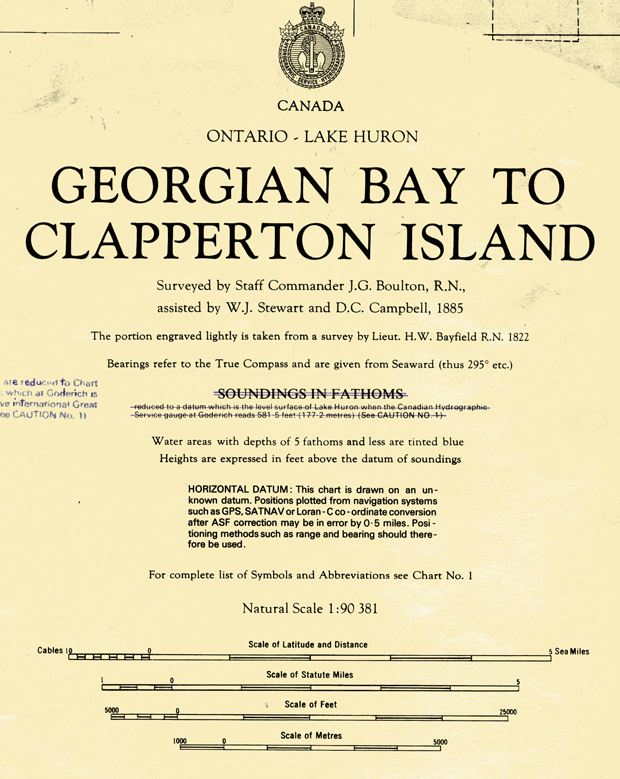Abel Buell's New and Correct Map of the United States, 1784
This landmark map of extraordinary significance to the historical record of the United States was published by Abel Buell in 1784. Notably, this is the first map of the newly independent United States compiled, printed, and published in America by an American. Additionally, it is also the first map to be copyrighted in the United States. Only seven copies are known to exist and survive in major institutions in the United States, the United Kingdom, and Spain. The copy on display is considered to be the best preserved of all extant editions and was officially deposited with the Library by Mr. David Rubenstein in January 2010.
I took three photographs of the map, concentrating on the Great Lakes and their depiction in 1784. I'd like to share these images and my comments about them.
First, here is a view of the lower peninsula of Michigan with the surrounding Lake Michigan and Lake Huron:
The western lakeshore portion of the lower peninsula is described as an "Extensive Sandy Desart"[sic]. There are extensive lakeshore sand dunes on that coastline.
The present Saginaw Bay is denoted as "Saguitiam Bay", perhaps more reflective of an Indian language pronunciation.
The central portion of the state is denoted as "A Plain 150-miles," which is still a good description of that area.
Manitoulin Island, part of Canada, is well defined and called "Manitoualin Isle."
On the left edge of the map (as seen in Figure 1) there is a notation of "Grand Travers", but it seems to be more associated with what we today call Green Bay, and not with the present-day Grand Traverse bay in northwest lower Michigan. There is a depiction of an unidentified bay which we can infer was Grand Traverse bay, but the orientation is off by 90-degrees. The actual bay runs North-South for 33-miles, not East-West as seen on the Abel Buell map. (I assume "Travers" is from a French origin; "travers" may mean "breadth" or a distance across, so "grand travers" would mean great breadth or great distance across.)
A fort is denoted on the map in the straits between Lake Michigan and Huron, and the area is called "Michillimacknac." Today we call that area the Straits of Mackinac.
Detroit was founded in 1701, and is prominent. A small circle and an icon of a building marks its location, although the city name seems to have landed in Canada instead of Michigan.
Native tribes of Indians and their regions are identified as Chipeways, Ottawas, Uttawas, Wymdots, and a location called Pontowatami Town is shown at the extreme lower left. (These are likely older spellings for Chippewa, Ottawa (Outaouais in French), Wyandot or Huron, and Potowatami tribes, and Chippewa now deprecated in favor of Ojibwa.)
Now we look at the Lake Superior region.
Isle Royale is nicely depicted, but perhaps wider than it actually is, and called "Isle Royal." The trailing "e" must have been added by later map makers.
A second large island called "Isle Phillipoux" is also shown, but as we now know, there is no such land interposed between the Keweenaw Peninsula and Isle Royale. Perhaps "Isle Phillipoux" was just the result of confusion about Isle Royale.
The Apostle Islands are shown--all thirteen of them.
Most interesting is a notation on the land west from the Keweenaw Peninsula that mentions "about here is Plenty Virgin Copper."
The map details more than two dozen rivers in the upper peninsula that drain into Lake Superior.
An archipelago of seven islands in eastern Lake Superior is noted as "Ponchartrain I." This is likely a confusion of today's Caribou Island and Michipicoten Island.
Along the north shore of Superior several large islands are shown on the Abel Buell map. These are drawn out proportion to their modern representation.
Overall, the Abel Buell map has filled Lake Superior with too many large islands. As we know today, Lake Superior is mostly a vast open lake.
Finally, we look at Lake Huron and Georgian Bay.
Notably missing is the identification of Georgian Bay, which geographers must have added later. The Bruce Peninsula is not identified but is nicely depicted. The chain of island from Tobermory over to the southeast shore of Manitoulin is also well drawn. Fitzwilliam Island is probably represented as the largest in that chain. The east shore of the deep inlet known as South Baymouth is depicted as an island.
Today's Nottawasaga Bay is called "St. Joseph." I don't see any modern map use of St. Joseph in that region, but there is a Christian Island on modern charts.
The original Abel Buell map that was on display was presented in rather subdued lighting, most likely to prevent any further decay to the map inks. The mapmaker, Abel Buell, was quite a colorful character. A wikipedia page gives some further details into his history as a map maker:
https://en.wikipedia.org/wiki/Abel_Buell
